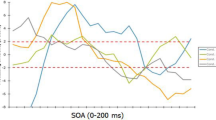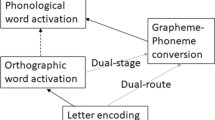Abstract
Percent contrast thresholds for the detection of 1 or 8 cycle/degree sinusoidalgratings flickering in counter-phase at 1 or 10Hz were evaluated in 356 8–19 year old twinsand their school-age siblings. 107 of the twinshad a school history of reading disability.Subjects adjusted contrast levels to thresholdfrom above and below in a total of 32 trialsover about 12 minutes. Internal reliability foreach of the 4 stimulus conditions was 0.8, andeach stimulus condition was similarlycorrelated at 0.2–0.3 with several measuresof reading and phonological processing,suggesting modest relations with readingdeficits for both parvocellular (sustained) andmagnocellular (transient) visual processes. Thevariance in the word-reading measure that wasrelated to visual contrast thresholds waslargely shared with full-scale IQ, although IQand reading each also accounted for small(1%) but statistically significant amounts ofadditional independent variance in contrastthresholds. Word reading and nonword readingalso accounted for largely overlapping variancein contrast thresholds, but with a small (1%)amount of independent variance for nonwordreading. A behavioral-genetic analysis of themonozygotic and dizygotic twin correlationsindicated no significant genetic influence onindividual differences in contrast-thresholdlevels.
Similar content being viewed by others
References
Barnard, N., Crewther, S.G. & Crewther, D.P. (1998). Development of a magnocellular function in good and poor primary school-age readers, Optometry and Vision Science 75: 62-68.
Borsting, E., Ridder, W.H., Dudeck, K., Kelley, C., Matsui, L. & Motoyama, J. (1996). The presence of a magnocellular deficit depends on the type of dyslexia, Vision Research 136: 1047-1053.
Breitmeyer, B.G. (1980). Unmasking visual masking: A look at the 'why' behind the veil of the 'how', Physiology Review 87: 52-69.
Breitmeyer, B.G. & Ganz, L. (1976). Implications of sustained and transient channels for theories of visual pattern masking, saccadic suppression and information processing, Psychological Review 83: 1-36.
Bruce, D.J. (1964). The analysis of word sounds by young children, British Journal of Psychology 34: 158-170.
Castles, A. & Coltheart, M. (1993). Varieties of developmental dyslexia, Cognition 47: 149-180.
Castles, A., Datta, H., Gayan, J. & Olson, R.K. (1999). Varieties of developmental reading disorder: Genetic and environmental influences, Journal of Experimental Child Psychology 72: 73-94.
Cestnick, L. & Coltheart, M. (1999). The relationship between language-processing andvisual-processing deficits in developmental dyslexia, Cognition 71: 231-255.
Cornelissen, P., Richardson, A., Mason, A., Fowler, S. & Stein, J. (1995). Contrast sensitivity and coherent motion detection measured at photopic luminance levels in dyslexics and controls, Vision Research 35: 1483-1494.
DeFries, J.C., Filipek, P.A., Fulker, D.W., Olson, R.K., Pennington, B.F., Smith, S.D. & Wise, B.W. (1997). Colorado Learning Disabilities Research Center, Learning Disability Quarterly 8: 7-19.
Dunn, L.M. & Markwardt, F.C. (1970). Peabody individual achievement test. Circle Pines, MN: American Guidance Service.
Eden, G.F., VanMeter, J.W., Rumsey, J.M., Maisog, J.M., Woods, R.P. & Zeffiro, T.A. (1996). Abnormal processing of visual motion in dyslexia revealed by functional brain imaging, Nature 382: 66-70.
Galaburda, A. & Livingstone, M. (1993). Evidence for a magnocellular defect in developmental dyslexia, Annals of the New York Academy of Sciences 682: 70-82.
Gross-Glenn, K., Skottun, B.C., Glenn, W., Kushch, A., Lingua, R., Dunbar, M., Jallad, B., Lubs, H.A., Levin, B., Rabin, M., Parke, L.A. & Duara, R. (1995). Contrast ensitivity in dyslexia, Visual Neuroscience 12: 153-163.
Farmer, M.E. & Klein, R.M. (1995). The evidence for a temporal processing deficit inked to dyslexia: A review, Psychonomic Bulletin and Review 2: 460-493.
French, J.W., Ekstrom, R.G. & Price, L.A. (1963). Manual for a kit of reference tests for cognitive factors. Princeton, NJ: Educational Testing Service.
Gilger, J., Pennington, B.F. & DeFries, J. (1992). A twin study of the etiology of comorbidity: Attention deficit-hyperactivity disorder and dyslexia, Journal of the American Academy of Child and Adolescent Psychiatry 31: 343-348.
Hayduk, S., Bruck, M. & Cavanagh (1992). Do adult dyslexics show low level visual processing deficits? Poster presented at the NYAS meeting, New York.
Hogben, J., Rodino, I., Clark, C. & Pratt, C. (1995). A comparison of temporal integration in children with a specific reading disability and normal readers, Vision Research 35: 2067-2074.
Hyona, J. & Olson, R.K. (1995). Eye fixation patterns among dyslexic and normal readers: Effects of word length and word frequency, Journal of Experimental Psychology: Learning, Memory, and Cognition 21(6): 1-11.
Jastak, J. & Wilkinson, G.S. (1984). The wide range achievement test-revised. Wilmington, DE: Jastak Associates.
Lovegrove, W.J., Martin, F., Bowling, A., Blackwood, M., Badcock, D. & Paxton, S. (1982). Contrast sensitivity functions and specific reading disability, Neuropsychologia 20: 309-315.
Manis, F. Seidenberg, M., Dow, L., McBride-Chang, C. & Peterson, C. (1996). On the bases of two subtypes of developmental dyslexia, Cognition 58: 157-195.
Martin, F. & Lovegrove, W.J. (1984). The effects of field size and luminance on contrast sensitivity differences between specifically reading disabled and normal children, Neuropsychologia 22: 73-77.
Martin, F. & Lovegrove, W. (1987). Flicker contrast sensitivity in normal and specifically disabled readers, Perception 16: 215-221.
McGee, R. & Share, D. (1988). Attention Deficit Disorder-Hyperactivity and academic failure: Which comes first and which should be treated?, Journal of the American Academy of Child and Adolescent Psychiatry 27: 318-325.
Olson, R.K., Conners, F.A. & Rack, J.P. (1991). Eye movements in dyslexic and normal readers. In: J.F. Stein (ed.), Vision and visual dyslexia (pp. 243-250). London: Macmillan.
Olson, R.K., Forsberg, H. & Wise, B.W. (1994). Genes, environment, and the development of orthographic skills. In: V. Berninger (ed.), The varieties of orthographic knowledge, Part I: Theoretical and developmental issues. Dordrecht/Boston/London: Kluwer Academic Publishers.
Olson, R.K., Forsberg, H., Wise, B. & Rack, J. (1994). Measurement of word ecognition, orthographic, and phonological skills. In: G.R. Lyon (ed.), Frames of reference for the assessment of learning disabilities: New views on measurement issues (pp. 243-277). Baltimore, MD: Paul H. Brookes Publishing Co.
Olson, R.K., Kliegl, R., & Davidson, B.J. (1983). Dyslexic and normal readers' eye movements, Journal of Experimental Psychology: Human Perception and Performance 9: 816-825.
Olson, R.K., Kliegl, R., Davidson, B.J. & Foltz, G. (1985). Individual and developmental differences in reading disability. In: G.E. MacKinnon & T.G. Waller (eds.), Reading research: Advances in theory and practice, Vol. 4 (pp. 1-64). New York: Academic Press.
Plomin, R., DeFries, J.C. & McClearn, G.E. (1990). Behavior genetics: A primer. San Francisco, CA: W.H. Freeman.
Rack, J.P., Snowling, M.J. & Olson, R.K. (1992). The nonword reading deficit in developmental dyslexia: a review, Reading Research Quarterly 27(1): 28-53.
Rodgers, B. (1983). The identification and prevalence of specific reading retardation, British Journal of Educational Psychology 53: 369-373.
Rutter, M. & Yule, W. (1975). The concept of specific reading retardation, Journal of Child Psychology and Psychiatry 16: 181-197.
Skottun, B.C. & Parke, L.A. (1999). The possible relationship between visual deficits and dyslexia: Examination of a critical assumption, Journal of Learning Disabilities 32: 2-5.
Sekuler, R., Hutman, L.P. & Owsley, C. (1980). Human aging and spatial vision, Science 209: 1255-1256.
Share, D.L. (1995). Phonological recoding and self-teaching: Sine qua non of reading acquisition, Cognition 55(2): 151-218.
Slaghuis, W., Twell, A. & Kingston, K. (1996). Visual and language processing deficits are concurrent in dyslexia and continue into adulthood, Cortex 32(3): 413-438.
Smith, A., Early, F. & Grogan, S. (1986). Flicker masking and developmental dyslexia, Perception 15: 473-482.
Victor, J., Conte, M., Burton, L. & Nass, R. (1993). Visual evoked potentials in dyslexics and normals: Failure to find a difference in transient or steady state responses, Visual Neuroscience 10: 939-946.
Walther-Muller, P. (1995). Is there a deficit of early vision in dyslexia? Perception 24: 919-936.
Wechsler, D. (1974). Examiner's manual: Wechsler Intelligence Scale for children-revised. New York: The Psychological Corporation.
Author information
Authors and Affiliations
Corresponding author
Rights and permissions
About this article
Cite this article
Olson, R., Datta, H. Visual-temporal processing in reading-disabled and normal twins. Reading and Writing 15, 127–149 (2002). https://doi.org/10.1023/A:1013872422108
Issue Date:
DOI: https://doi.org/10.1023/A:1013872422108




